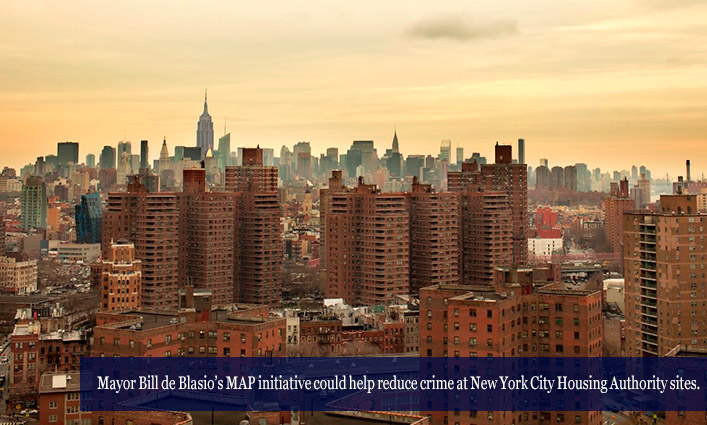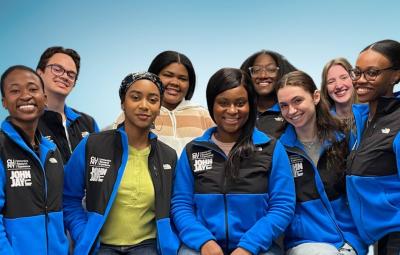
Researchers at the John Jay Research & Evaluation Center (JohnJayREC) are evaluating the effectiveness of the city’s latest experiment at curbing violence by analyzing data, looking at the statistics, and talking to the people living in New York City’s public housing system.
“This is a major undertaking by the city of New York to improve living conditions for residents of public housing,” says Jeffrey A. Butts, Ph.D., Director of JohnJayREC. Launched in 2014 by the Mayor’s Office of Criminal Justice (MOCJ), the New York City Mayor’s Action Plan for Neighborhood Safety (MAP) is a $210 million initiative aimed at reducing crime by improving quality of life at 17 New York City Housing Authority (NYCHA) developments. NYCHA residents are among the city’s poorest with a median household income below $25,000. They’re also among the most victimized. While crime rates have decreased for most of the city, it has remained high across the deteriorating public housing system where residents can go days without gas or heat. The 17 chosen MAP sites led the city in indicators of disadvantage, such as high crime rates and low household income, and represent 20 percent of New York City’s violent crime. Recently, a 62-year-old man was brutally attacked in the lobby of a Tompkins NYCHA building, one of the MAP sites.

Evaluation Center at John Jay College of Criminal Justice
Creating a Safer Community
According to MAP, “evidence shows that disorder, negligence, and decay undercut neighborhood stability” leading to higher crime rates. Enforcement alone won’t solve the problem. Instead, factors such as access to resources, economic advantage, relationships between residents and their government, and ordered space play a key role in reducing violent crimes. The MAP initiative aims to increase safety, and give NYCHA residents a feeling of safety, by investing in their community. Investments include beautification projects that will see vacant lots turn into green spaces, security upgrades, extended community center hours, and employment opportunities for youth ages 14-24 through the city’s Summer Youth Employment program (SYEP). In fiscal year 2017, 4,025 MAP youths applied for SYEP, an increase of 600 people from the previous year. MAP is also bringing together several agencies in an “All In” campaign to help increase outreach in the communities and ensure opportunities, such as SYEP, are visible to NYCHA residents.
“This is a major undertaking by the city of New York to improve living conditions for residents of public housing.” – Jeffrey A. Butts, Director of JohnJayREC
Measuring the Impact of MAP
In order to measure, or quantify, the impact of MAP, researchers from JohnJayREC worked in partnership with researchers from NORC at the University of Chicago to create an assessment that would help measure MAP’s efficacy. The MAP Evaluation will analyze changes in 34 communities during the MAP time period—from 2014 to 2019. In total, 17 of the city’s 326 public housing developments—there are 400,000 plus residents living in NYCHA buildings—were chosen to participate as a MAP site, while another 17 NYCHA development non-MAP sites were chosen as a control group. By collecting data from both pools researchers will be able to measure what real changes have taken place and what would happen in MAP communities if MAP initiatives were never put in place.
Evaluating MAP’s impact will be a complex process. “We are measuring the possible impact of MAP by using several strategies,” says Butts. The multi-modal approach includes various measurement strategies and data from law enforcement, stats on victimization, an analysis of individual survey responses, as well as multiple observations. “We’re collecting all the possible administrative data we can get our hands on,” says Butts. “We’re getting data from a variety of social services partners that touch these communities in any way.”
Researchers are also using survey research and direct observation to help in their study. This helps them stay up to date on issues plaguing the community. “The JohnJayRec staff goes to meetings involving the MAP communities. They go to the local Neighborhood Stat or ‘NStat’ meetings where neighbors review crime data and public safety data,” says Butts. Each MAP NYCHA site participates in the NStat meetings.
Measuring Attitude Changes
Researchers at JohnJayREC also hope to learn if the MAP initiative is helping to strengthen the relationship between NYCHA residents and local government officials, law enforcement, and other city agencies. “We asked them a series of questions about their lives, their living conditions, their thoughts about their communities, and their thoughts about police and local government,” says Butts. “We use those survey results to see if the people in the MAP properties have more positive attitudes towards the city after all this effort.”
JohnJayREC researchers expect to complete the MAP Evaluation study in 2020. At that time data and analysis from the two sets of NYCHA sites will be compared and researchers will be able to determine MAP’s effect on public safety.



